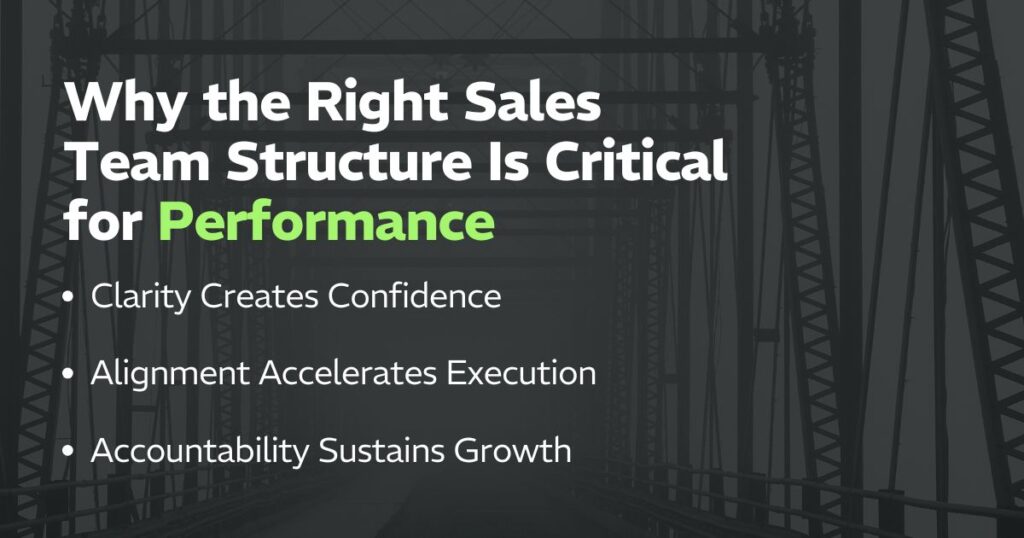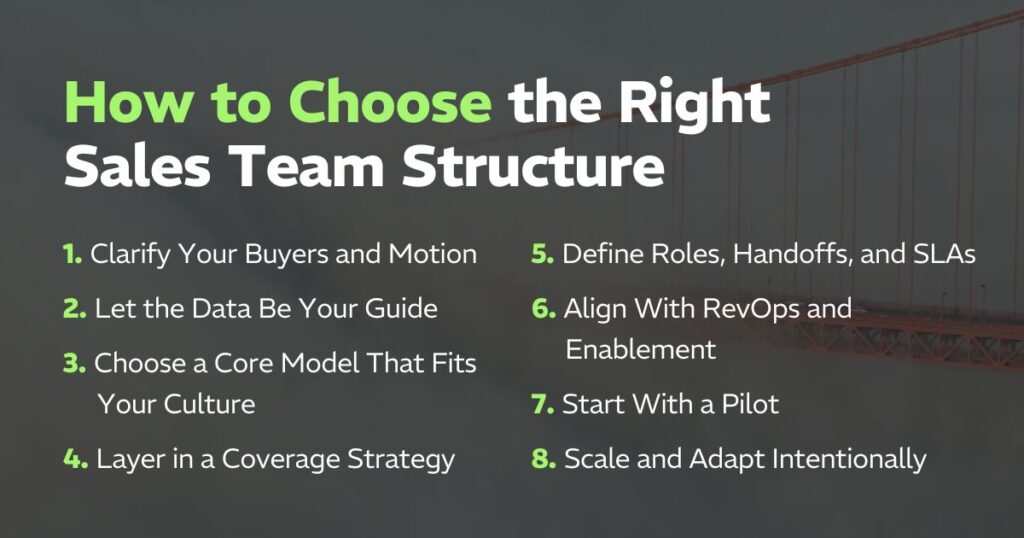Without clear roles and responsibilities, even the best sales reps end up working hard but not working together. Managers get stuck in the weeds. Customers feel the friction. Growth slows.
Figuring out how to build a sales team structure that truly works is one of the hardest—and most important—things a growth leader can do. The decisions you make about design, accountability, and alignment will determine whether your sales teams scale smoothly or struggle under their own weight.
The best structures are lean, role-clarified, and customer-centric. They’re built for collaboration, sales coaching, and agility so every rep is set up to win and every team member stays connected. Strong structure helps your team close deals faster and sustain performance that lasts for the long term.
Why the Right Sales Team Structure Is Critical for Performance
Structure is more than an org chart. It’s the engine that turns individual effort into collective performance and a foundation for improving sales team performance at scale.
When design, process, and leadership align, sales teams move faster, focus better, and deliver a more consistent customer experience.
Clarity Creates Confidence
High performing sales teams don’t guess who owns what. Defined roles and responsibilities make expectations visible and decisions faster. Clarity gives sales team members confidence to execute and helps sales managers coach in the moments that matter. When everyone understands their lane, energy shifts from internal confusion to customer impact.
Alignment Accelerates Execution
Structure connects people to purpose. When the organization mirrors the buyer journey, marketing, sales, and success find momentum through harmony instead of in silos. Aligned goals, shared metrics, and coordinated handoffs keep momentum moving forward. Alignment removes friction so strategy becomes execution.
Accountability Sustains Growth
Sustained performance depends on a sense of ownership and shared purpose. The most effective leaders know how to motivate their sales teams to stay engaged through change.
A strong structure defines who is responsible for each stage of the customer lifecycle and what success looks like. That accountability allows for meaningful measurement, real coaching, and smarter decisions about where to invest time and talent. It’s how short-term wins evolve into long-term growth.

The Most Common Sales Team Structure Models
Sales team structures vary, but most organizations organize around a few proven patterns for sales models. The right one helps you align people to process and customers to expertise. While every company tailors its approach, most modern sales organizations draw from three primary frameworks.
The Island Model (Full-Cycle)
In the Island Model, each sales rep manages the entire sales process from start to finish—prospecting, qualifying, closing, and managing the relationship. Every rep is a self-contained business unit responsible for pipeline, performance, and customer experience.
This model gives sellers full ownership of results and allows organizations to move quickly with minimal coordination layers. It’s often the foundation for small or early-stage teams where simplicity and speed matter most.
The Assembly Line Model (Specialized)
The Assembly Line Model divides the sales process into distinct stages, with each role focusing on a specific part of the funnel. Business Development or SDR teams handle lead generation, Account Executives manage evaluation and closing, and Customer Success or Account Management teams oversee onboarding, retention, and expansion.
By separating stages, the organization can create clear roles and workflows that mirror the customer journey. Each function develops expertise in its area, creating a scalable process that connects marketing, sales, and success around shared outcomes.
The Pod Model (Cross-Functional)
The Pod Model brings cross-functional collaboration to the center of the sales motion. Each pod includes a small group of specialists—typically an SDR, AE, and CSM—who work together to serve a defined customer segment, vertical, or region.
This structure combines the focus of specialization with the connection of teamwork. Pods stay close to the customer, align around common goals, and share accountability for results. The model scales by adding new pods as markets expand, creating repeatable, customer-centered growth.
Most effective sales teams draw inspiration from these three approaches and adapt them over time. Whether you start with individual ownership, process specialization, or collaborative pods, the goal remains the same: to design a structure that supports your strategy and serves your customers effectively.
Comparing Sales Team Structure Models
Island Model (Full-Cycle)
- When it works: Early‑stage companies and complex, relationship‑driven sales where a single point of contact builds trust.
- Pros: High autonomy, speed, and creativity. Strong customer intimacy.
- Cons: Limited knowledge sharing; uneven process; harder to scale or forecast.
- Watchouts: Define guardrails so full‑cycle reps still follow consistent methodology.
Assembly Line Model (Specialized)
- When it works: High‑volume motions, predictable pipeline, clear segmentation (common in SaaS).
- Pros: Efficiency from specialization, clearer career ladders, easier capacity planning.
- Cons: Handoff risk; customers can feel the seams if enablement and SLAs aren’t tight.
- Watchouts: Invest in enablement, routing, and shared metrics across SDR → AE → AM/CSM to keep the experience contiguous.
Pod Model (Cross‑Functional)
- When it works: Complex accounts, account‑based strategies, or when collaboration and customer experience are strategic differentiators.
- Pros: Shared accountability, tighter collaboration, better coverage of the full customer lifecycle.
- Cons: Heavier coordination; requires strong pod leadership and clear goals.
- Watchouts: Avoid duplicative roles; assign a single pod owner for revenue outcomes.
Hybrid Models
Most modern organizations blend models to fit their market strategy: specialized roles for inbound/outbound, pods for strategic accounts, and vertical overlays for industry expertise.
Examples of effective hybrids
- Assembly + Pod: SDR/AE specialization for velocity deals; pods for enterprise pursuits.
- Geographic + Product: Field coverage by territory with inside specialists by product line.
- Market‑based: Teams aligned to verticals (healthcare, financial services) with product experts attached.
How to Choose the Right Sales Team Structure
Successful sales organizations don’t pick a structure from a template. They design it from strategy by aligning how the team is built to how customers buy, what the data shows, and how people do their best work.
Here’s a practical, eight-step framework for designing a structure that supports performance today and scales for tomorrow.
1. Clarify Your Buyers and Motion
Start with the customer. Who are you selling to, and how do they buy? The buyer journey should drive your structure.
Straightforward sales cycles can thrive with full-cycle ownership. Complex, multi-stakeholder deals often require specialization or pods. Map responsibilities from first touch through renewal so the structure mirrors how customers evaluate your products or services.
2. Let the Data Be Your Guide
Average contract value (ACV), sales cycle length, and lead volume determine whether specialization will pay off.
High ACV and longer cycles justify dedicated roles and clean handoffs. Smaller or emerging teams often start blended until scale demands specialization. The math helps ensure the structure you choose fits the motion you’re actually running.
3. Choose a Core Model That Fits Your Culture
Structure defines what gets done and in what order, but culture determines how it comes together. The best design balances operational efficiency with your team’s work preferences.
If your culture values autonomy and ownership, an island or hybrid model may be best. If collaboration and shared learning are your strengths, pods can amplify that advantage. The right structure should make your culture more visible, not work against it.
4. Layer in a Coverage Strategy
Coverage determines focus. Decide how to segment the market so your team spends time where it creates the most impact.
You can organize by territory, vertical, account size, or product line or blend these based on your go-to-market motion. Many growth-stage organizations align pods to a vertical or ideal customer profile to improve message fit and pipeline quality. Review coverage regularly to ensure capacity matches opportunity.
5. Define Roles, Handoffs, and SLAs
Clarity is the foundation of execution. Spell out ownership by stage (SDR, AE, CSM, etc.) and document what good handoffs look like.
Establish service-level expectations for response time, data quality, and accountability. When ownership is clear, teams collaborate naturally and focus on the customer instead of internal confusion.
6. Align With RevOps and Enablement
Structure succeeds only when systems support it. RevOps unites sales, marketing, and customer success around shared data and metrics.
Your sales enablement team ensures the people inside that system have what they need to perform—training, tools, and the right sales content. Keep your enablement team structured around your sales motion, not one-off requests. A strong sales enablement manager turns process into progress by connecting learning, data, and performance.
7. Start With a Pilot
Before a full rollout, test your design. Choose one region, segment, or motion and define what success looks like—pipeline creation, conversion, customer satisfaction, or time to ramp.
Use those insights to refine before scaling. Partner with your RevOps and enablement teams to track what’s working and where friction still exists. A short pilot can save months of rework.
8. Scale and Adapt Intentionally
Building a high performing sales isn’t a single decision. As your organization grows, continue to evolve how teams work together. Clone what works. Adjust what doesn’t.
Many companies blend models as they mature: using assembly-line specialization for inbound velocity and pods for enterprise or strategic accounts. Keep sales enablement efforts focused on helping the team adapt to changing motions, not just adding new tools or training.

Design Your Sales Team Structure for Scale, Not Just Today
Your structure should serve today’s needs and tomorrow’s growth. Here’s a pragmatic way to design for scale as you consider how to manage a sales team.
Early‑Stage (1–10 reps)
- Goal: Validate the selling motion while staying close to the customer.
- Structure: Mostly island with light specialization (one person focused on outbound; founder‑led strategic deals).
- Leadership: Player‑coach managers.
- Operating system: A simple stage‑based process, tight feedback loop with product/marketing, and an enablement hub with only the essentials.
- Metrics: New pipeline created, first‑meeting‑to‑opportunity conversion, early win rates, sales cycle length.
Growth Stage (10–50+ reps)
- Goal: Add specialization and consistency without over‑engineering.
- Structure: Assembly line becomes the backbone (SDR → AE → AM/CSM). Introduce solutions engineering for complex demos and RevOps to stabilize process, tooling, and data quality.
- Leadership: Dedicated frontline managers with manageable spans; enablement to drive onboarding and ongoing training.
- Operating system: Quarterly territory planning; formal SLA/exit criteria between stages; codified playbooks per segment.
- Metrics: Quota attainment, conversion rates by stage, ACV, cycle time, pipeline coverage (≥3× bookings target).
Enterprise (50–500+ reps)
- Goal: Orchestrate complex sales and expansion across segments and products.
- Structure: Pods for strategic accounts; verticalized teams for industry depth; overlay roles (solutions consultants, product specialists).
- Leadership: Second‑line leaders over regions/segments; clear accountability for new ARR vs. expansion/renewal.
- Operating system: Account plans, executive sponsorship, formal QBRs, and a robust enablement calendar.
- Metrics: Net revenue retention, multi‑threading depth, whitespace penetration, expansion rate, customer health.
Build for Scale. Lead for Impact.
The right sales team structure is a competitive advantage. It’s the system that turns strategy into execution and execution into growth.
As your business evolves, continue refining how teams work, how managers coach, and how your enablement strategy supports success. Align structure with culture, customer experience, and long-term vision — not just short-term results.
If you’re ready to take the next step in developing sales leadership skills to build high-performing teams. download the Human-Centered Growth Playbook. Inside, you’ll find a practical, people-first model for building high-performance teams, strengthening culture, and leading through complexity with clarity, connection, and purpose.










